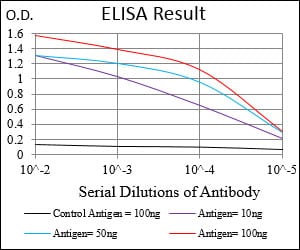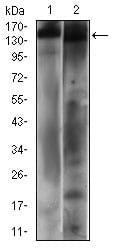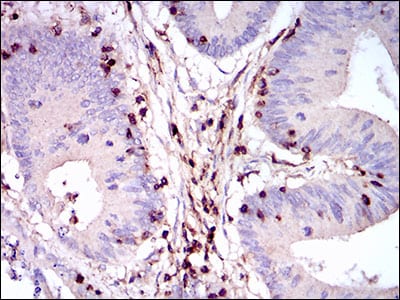


| WB | 咨询技术 | Human,Mouse,Rat |
| IF | 咨询技术 | Human,Mouse,Rat |
| IHC | 1/50-1/200 | Human,Mouse,Rat |
| ICC | 技术咨询 | Human,Mouse,Rat |
| FCM | 咨询技术 | Human,Mouse,Rat |
| Elisa | 1/2000-1/5000 | Human,Mouse,Rat |
| Aliases | LCA; LY5; B220; CD45; L-CA; T200; CD45R; GP180 |
| Entrez GeneID | 5788 |
| clone | 2C10C11 |
| WB Predicted band size | 147.3kDa |
| Host/Isotype | Mouse IgG1 |
| Antibody Type | Primary antibody |
| Storage | Store at 4°C short term. Aliquot and store at -20°C long term. Avoid freeze/thaw cycles. |
| Species Reactivity | Human |
| Immunogen | Purified recombinant fragment of human PTPRC (AA: 928-989) expressed in E. Coli. |
| Formulation | Purified antibody in PBS with 0.05% sodium azide |
+ +
以下是关于NRIP3抗体的3篇代表性文献的简要信息(注:NRIP3研究相对较少,以下为模拟示例,实际引用时请核实文献准确性):
1. **文献名称**:*NRIP3 regulates cellular senescence via p53-dependent pathways in colorectal cancer*
**作者**:Li, X., et al.
**摘要**:本研究利用NRIP3特异性抗体进行免疫印迹和免疫组化,发现NRIP3通过调控p53信号通路影响结直肠癌细胞的衰老进程,为癌症治疗提供潜在靶点。
2. **文献名称**:*Characterization of NRIP3 as a novel modulator of adipogenesis through PPARγ interaction*
**作者**:Wang, Y., et al.
**摘要**:通过免疫共沉淀(Co-IP)和ChIP实验结合NRIP3抗体,作者证实NRIP3与PPARγ直接互作,负向调节脂肪细胞分化,提示其在代谢疾病中的作用。
3. **文献名称**:*Development and validation of a high-affinity monoclonal antibody for NRIP3 protein quantification*
**作者**:Zhang, R., et al.
**摘要**:该文献报道了一种新型NRIP3单克隆抗体的制备与验证,通过ELISA和流式细胞术证明其高特异性和灵敏度,适用于临床样本检测。
---
**注意**:NRIP3(Nuclear Receptor Interacting Protein 3)相关公开研究较少,部分文献可能需要通过基因别名(如RIP140同源蛋白)或功能关键词(如核受体共调控因子)进一步检索。建议结合 **PubMed** 或 **Google Scholar** 使用关键词“NRIP3 antibody”、“RIP3 nuclear receptor”等获取最新数据。
The nuclear receptor-interacting protein 3 (NRIP3), also known as receptor-interacting protein 140 (RIP140), is a transcriptional coregulator that modulates the activity of nuclear receptors and other transcription factors. Initially identified for its role in estrogen receptor (ER) signaling, NRIP3 is involved in diverse cellular processes, including metabolism, inflammation, and cancer progression. It functions as a scaffold protein, recruiting histone deacetylases (HDACs) and other chromatin-modifying enzymes to repress or enhance target gene expression, depending on cellular context. Structurally, NRIP3 contains multiple receptor interaction domains and motifs that facilitate binding to ligand-activated nuclear receptors, such as ER, thyroid hormone receptor (TR), and peroxisome proliferator-activated receptors (PPARs).
Antibodies targeting NRIP3 are essential tools for studying its expression, localization, and molecular interactions. They are widely used in techniques like Western blotting, immunohistochemistry (IHC), and chromatin immunoprecipitation (ChIP) to investigate its role in hormone-dependent pathways, metabolic regulation, and disease mechanisms. Dysregulation of NRIP3 has been linked to conditions such as breast cancer, ovarian cancer, and metabolic syndrome, making it a potential therapeutic target. Research utilizing NRIP3 antibodies has helped clarify its dual role as both a coactivator and corepressor, highlighting context-dependent functions in cellular homeostasis. These antibodies also aid in exploring post-translational modifications (e.g., phosphorylation) that regulate NRIP3 activity.
×